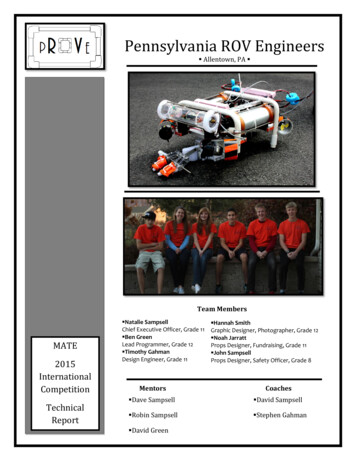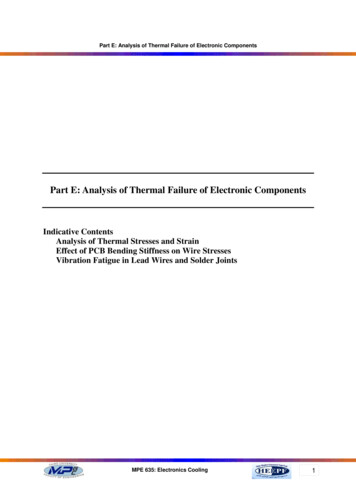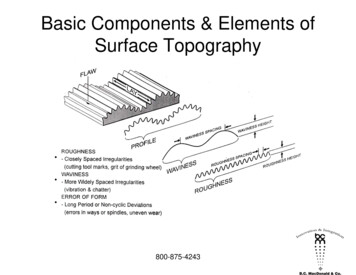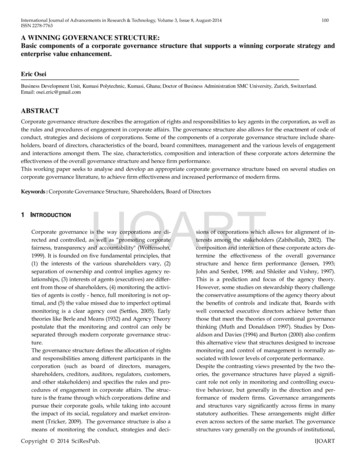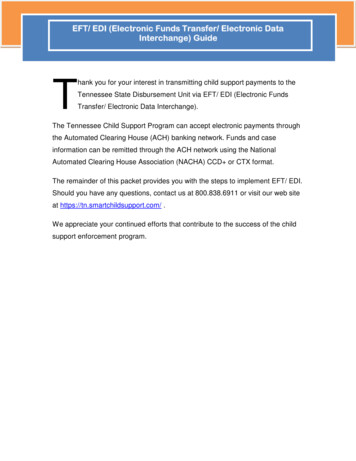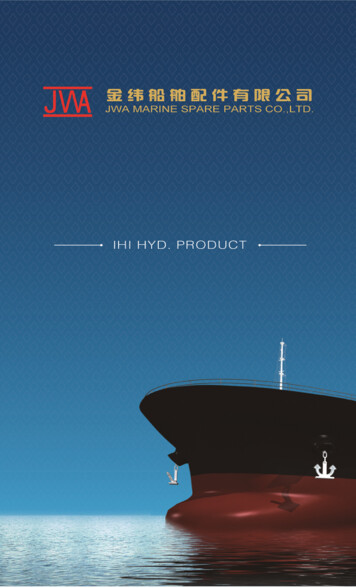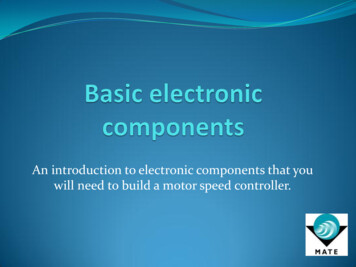
Transcription
An introduction to electronic components that youwill need to build a motor speed controller.
Resistors A resistor impedes the flow of electricity through a circuit. Resistors have a set value. Since voltage, current and resistance are related through Ohm’slaw, resistors are a good way to control voltage and current inyour circuit.2
More on resistors Resistor color codes1st band 2nd band 3rd band 4th band 1st number2nd number# of zeros / multipliertolerance3
Color code Tolerance: Gold within 5%Black: 0Brown: 1Red: 2Orange: 3Yellow: 4Green: 5Blue: 6Violet: 7Gray: 8White: 94
Units Knowing your units is important! Kilo and Mega are common in resistors Milli, micro, nano and pico can be used in othercomponentsK (kilo) 1,000M (mega) 1,000,000M (milli) 1/1,000u (micro) 1/1,000,000n (nano) 1/1,000,000,000 (one trillionth)p (pico) 1 / 1,000,000,000,000 (one quadrillionth)5
Capacitors A capacitor stores electrical energy. This pool of electrons is available for electronic components touse.Capacitance is measured in Farads. The small capacitors usually used inelectronics are often measured in microfarads and nanofarads.Some capacitors are polarized. Note thedifferent length terminals on one of the capacitors.6
Polarity of capacitors The shorter terminal goeson the negative side. The stripe is on thenegative terminal side ofthe capacitor. The board is marked forpositive or negative.7
Applications of capacitors Capacitors supply a pool of electrons for immediate use. If a component needs an immediate supply of electrons, thecapacitor can supply those electrons. Capacitors can smooth out a signal – eliminate the ripplesor spikes in DC voltage. The capacitor can absorb the peaks and fill in thevalleys of a rippled signal.8
Diode A diode is a one way valve (or gate) for electricity. It is acomponent with an asymmetrical transfer characteristic. Adiode has low (ideally zero) resistance in one direction, andhigh (ideally infinite) resistance in the other direction. Diodes will protect your electronics.9
Diode circuit protection In a DPDT switch, if polarity is wrong, the motor will runbackwards. In an electronic circuit, if the polarity is wrong, you can fryyour components.A diode in your system will help to prevent problems.Diodes have a baron the cathode(negative) side.10
Light emitting diode (LED) A light emitting diode (LED) is a semiconductor light source.When electricity is passing through the diode, it emits light. Jeremy is going to talk a lot more about LEDs.11
Variable resistor / Potentiometer A potentiometer is a variable resistor. As you manuallyturn a dial, the resistance changes.12
How a variable resistor works As the dial/wiper turns, electricity must go throughmore or less of the resistive strip.In series, the change in resistance means a change in voltage. So as you turn thedial/wiper, you geta change in voltage.13
Transistors A transistor is a semiconductor device used to amplifyand switch electronic signals and electrical power. This is our electronic switch!14
How a transistor works A voltage or current applied to one pair of thetransistor’s terminals changes the current throughanother pair of terminals. A transistor is composed of semiconductor materialwith at least three terminalsfor connection to an externalcircuit.Transistors have 3 pins.For these transistors:CollectorEmitterBase15
Terminology BJT versus FET Bipolar junction transistor. Useful as amplifiers.Collector, Emitter, Base Field-effect transistor. Useful as motor drivers.Source, Drain, GateMOSFET: Metal-oxide-semiconductor FET NPN (N-channel FET) versus PNP (P-channel FET) NPN versus PNP is how the semiconductors are layered.NPN: Not pointing inPNP: Pointing in permanently16
Schematic symbolsBJT PNPP-channel FETBJT NPNN-channel FET17
Integrated circuit An integrated circuit (IC) is a set of transistors that isthe controller or ‘brain’ of an electronic circuit. An input is received, an output is sent out.Modern microprocessor ICs can have billions oftransistors per square inch!18
What an IC can do for us? Billions of electronically controlled on/off switches(transistors) is how the microprocessor in a digitalcomputer ‘thinks’ and functions. A computer has a wide range of tasks to perform. But other ICs can complete simpler, discrete jobs.For example, an IC can take a voltage input and outputcommands to a motor.19
IC Terminology: Op-amp An operational amplifier (op-amp) is a set oftransistors inside the integrated circuit. They often arethe components doing the mathematical operations.20
H-bridge An electronic circuit that enables voltage to be appliedacross a load in either direction. A DPDT switch also does this, but not electronically.21
H-bridge Need four electronic switches. Either have 1 and 4 closed. Or 2 and 3 closed. What happens if both 1 and 2 are closed? The H-bridge allows electricity to flow both ways across the motor,which gives us forward and reverse. We can use pulse width modulation to control how often theswitches are on versus off, which gives us speed control.22
Varying voltage A potentiometer/variable resistor allows you tochange the voltage input that goes into the integratedcircuit. Integrated circuit can now output variety of pulse widthsto the transistors on the H-bridge. This combination of potentiometer, integrated circuit andPWM to the H-bridge is the key to speed control.23
Why not skip the IC? There are a couple reasons we don’t use just apotentiometer to control the speed of our motors. Potentiometers are rarely used to control significant power (morethan a watt). You would still need a way to switch the direction of the motor. Justusing a potentiometer can control speed, but not direction. DPDT switch and potentiometer combinations can lead toproblems if you quickly switch from full forward to full reverse.Problems can occur if the polarity of a spinning DC motor getssuddenly switched from forward to reverse. Current surgeMechanical stress24
Printed Circuit Board Components are attached to a printedcircuit board. The ‘front’ side of the board will haveprinted component information, suchas resistor # and resistance, diode typeand polarity, etc. Holes go all the way through the boardfrom one side to the other. Throughhole soldering is needed to connectcomponents to the board.25
Back of Circuit Board The ‘back’ side of the board will have lines indicatingconnections between components. The lines on theback are similar to wires. Thicker lines denote more current (electrons) movingthrough. Components connect the lines.26
Conclusion Hopefully that wasn’t tooconfusing.The goal was to give you a basicunderstanding of how some of theelectronic components of a motorspeed controller work.There are lots of tools to help youwith the basics.27
Why not skip the IC? There are a couple reasons we don’t use just a potentiometer to control the speed of our motors. Potentiometers are rarely used to control significant power (more than a watt). You would still need a way to switch the direction of the motor.Just using a

